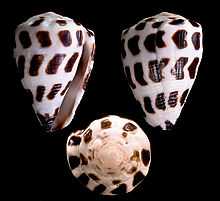Conus ebraeus
| Conus ebraeus Temporal range: Pleistocene–recent[1] | |
|---|---|
 | |
| Three different views of a shell of Conus ebraeus | |
| Scientific classification | |
| Kingdom: | Animalia |
| Phylum: | Mollusca |
| Class: | Gastropoda |
| (unranked): | clade Caenogastropoda clade Hypsogastropoda clade Neogastropoda |
| Superfamily: | Conoidea |
| Family: | Conidae |
| Subfamily: | Coninae |
| Genus: | Conus |
| Species: | C. ebraeus |
| Binomial name | |
| Conus ebraeus Linnaeus, 1758[2] | |
| Synonyms[3] | |
| |
Conus ebraeus, common name the black-and-white cone, is a species of sea snail, a marine gastropod mollusk in the family Conidae, the cone snails and their allies.[3]
Description
Conus ebraeus has easily recognisable small, squat shell, with a rounded, short spire.[3]
The shell is white, with a pattern of blackish squares,[3] sometimes rose-tinted, with three or four revolving bands composed of irregular longitudinal dark chocolate or nearly black markings; these markings also ornament the slightly coronated spire.[4] The aperture is white with clouded bands corresponding with the exterior markings.[4] The surface is more or less striate throughout, but striae are more prominent towards the dark stained base.[4]
The width of the shell of type specimen is 19 mm.[1] The height of the shell of type specimen is 28 mm.[1]
The height of the shell varies from 25 mm to 62 mm.[1]
Distribution
Conus ebraeus is one of the most widely distributed members of its genus and occurs in shallow water, tropical regions throughout the Indo-West and eastern Pacific, from the Red Sea to the shores of the Americas.[5]
The type locality is India.[1]
Localities include:
- Aldabra[3]
- Chagos[3]
- Guam[5]
- Hawaii[5]
- Houtman Abrolhos
- Kenya[3]
- Madagascar[3]
- Mascarene Basin[3]
- Mozambique[3]
- Okinawa[5]
- Red Sea[3]
- Tanzania[3]
- West Coast of South Africa[3]
Habitat
Conus ebraeus lives near rocky shores,[3] lower eulittoral, often under boulders.[3]
Feeding habits
Like all species within the genus Conus, these snails are predatory and venomous. They are capable of "stinging" humans, therefore live ones should be handled carefully or not at all.
While the focal prey of Conus ebraeus are eunicid polychaetes (i.e., members of the genus Palola) at most locations in the Indo-West Pacific (e.g., the Maldives, eastern Indian Ocean, Great Barrier Reef, Okinawa and Guam), at Hawaii and the Seychelles this species predominantly preys on nereid polychaetes.[5] These results suggest that Conus ebraeus exhibits geographic variation in dietary specialization.[5]
Prey of Conus ebraeus include Perinereis helleri (family Nereididae), Palola sp., Eunice cariboea and Lysidice collaris (all three from family Eunicidae).[5]
Gallery
-

Conus ebraeus Linnaeus, C., 1758
-

Conus ebraeus Linnaeus, C., 1758
-

Conus ebraeus Linnaeus, C., 1758
-
Conus ebraeus Linnaeus, C., 1758
References
This article incorporates CC-BY-2.5 text from the reference [5] and CC-BY-SA-3.0 text from the reference [3] and public domain text from the reference.[4]
- ↑ 1.0 1.1 1.2 1.3 1.4 "Conus ebraeus Linnaeus, 1758.". The Conus Biodiversity website, accessed 28 March 2010.
- ↑ Linnaeus C. (1758). Systema Naturae, 10th ed., 1.
- ↑ 3.0 3.1 3.2 3.3 3.4 3.5 3.6 3.7 3.8 3.9 3.10 3.11 3.12 3.13 3.14 3.15 Conus ebraeus Linnaeus, 1758. Retrieved through: World Register of Marine Species on 27 March 2010.
- ↑ 4.0 4.1 4.2 4.3 Tryon G. W. (1884). Manual of Conchology, structural and systematic, with illustrations of the species. Volume 6. Conidae, Pleurotomidae. page 20. Plate 5, figure 75-77, Plate 37, figure 13. (Cited as Conus hebraeus.) Plate 2, figure 25.
- ↑ 5.0 5.1 5.2 5.3 5.4 5.5 5.6 5.7 Duda T.F. Jr., Chang D., Lewis B. D. & Lee T. (2009). "Geographic Variation in Venom Allelic Composition and Diets of the Widespread Predatory Marine Gastropod Conus ebraeus". PLoS ONE 4(7): e6245. doi:10.1371/journal.pone.0006245
External links
| Wikimedia Commons has media related to Conus ebraeus. |
